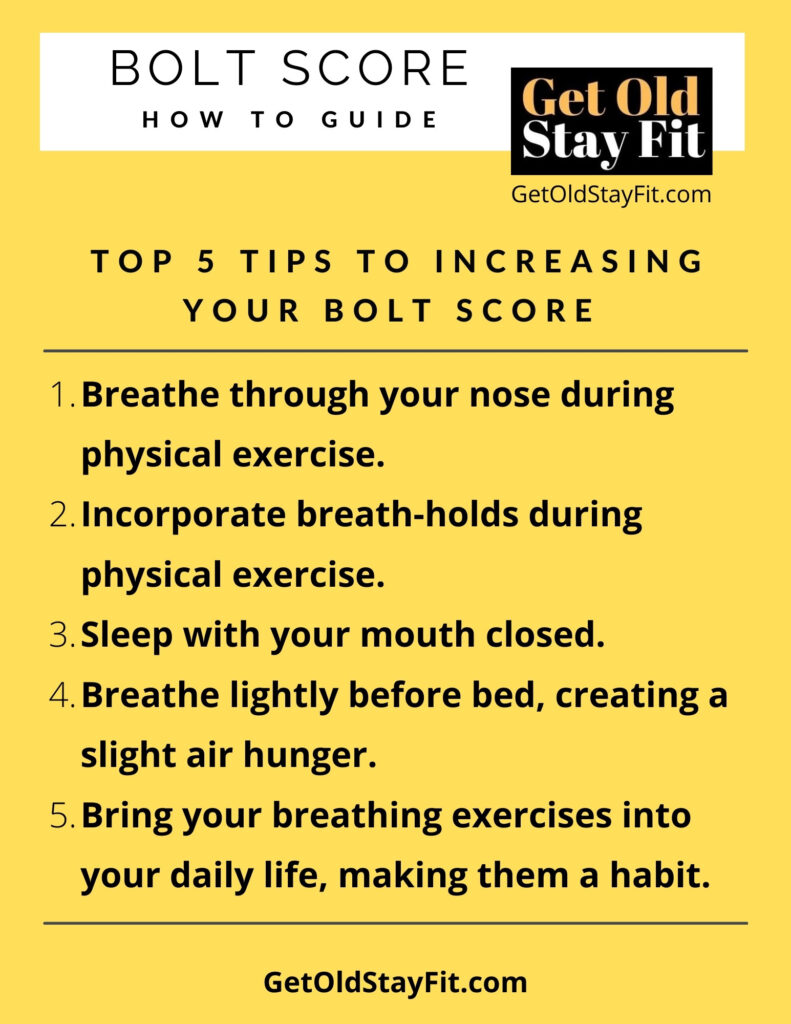If you’ve done any research on breathing techniques and the importance of breathing through your nose, then you’ve probably come across something called your Bolt Score.
It’s called the Body Oxygen Level Test (BOLT) and can be a useful tool to determine your relative breathing volume.
When your BOLT score is low, it’s a sign of a sensitivity to carbon dioxide. One of the problems created with carbon dioxide sensitivity is an urge to take quick breaths or over-breathe.
What is a Bolt Score
A BOLT score is a simple way to measure your tolerance to carbon dioxide by measuring your breath-hold time. The levels of carbon dioxide in your body, and how your body responds to it, create breathing patterns.
Your body might be telling you to breathe because carbon dioxide is the primary stimulus for your body to take a breath.
But many people over-breathe and don’t even realize it. They mistakenly think breathing more increases oxygen uptake, but it’s not that simple.
How excessive breathlessness is created is not easily understood, yet so important to health in everyday life.
Carbon Dioxide Importance
Excessive breathing removes the necessary carbon dioxide from our lungs. In exhalation, excess carbon dioxide is removed from our bodies.
This was once considered a good thing because of the misunderstanding of what carbon dioxide actually does and its importance.
What was once thought of as a waste product is now studied as one of the most important gasses in the universe, right up there with oxygen.
How to Check Your BOLT Score
Checking your breathing fitness with a bolt test is a simple way to gauge your body’s ability to tolerate too much carbon dioxide. A low BOLT score indicates a low tolerance for carbon dioxide.
A high BOLT score says your body can handle carbon dioxide, therefore breathing slower, smoother, with calm breathing, and longer times in between each breath.
- After resting for about ten minutes, set a stopwatch, and take a normal breath through your nose.
- Now exhale through your nose, and when you reach the end of the exhale, pinch your nose closed with your fingers.
- Keeping your mouth closed and your nose pinched, begin the timer on your breath-hold.
- Watch the clock and determine the number of seconds before your body has the first definite desire to breathe.
- When you feel the lack of air and the first urge to take a breath, resume breathing, and look at the stopwatch. Your BOLT score time is an accurate measurement of your sensitivity to carbon dioxide.
- That’s it. The simple breath hold test is complete. Now your next task is to improve your score with daily breathing exercises.
What is a Good Bolt Score?
This is your BOLT score. You might also experience involuntary contractions of your breathing muscles; this is perfectly normal.
The contractions are your body sending signals to take a breath. The lower the BOLT score, the more sensitivity to carbon dioxide. According to some breathing experts, an ideal BOLT score is 40 seconds or greater.
Beginners who are just starting out with a BOLT test for the first time might have a score of only 20 seconds or less.
This is not a test of how long you can hold your breath; it’s just the time it takes for your body to signal it’s time to breathe.
When you release your nose and begin breathing again, it should be with calm, normal breathing.
What Does the Bolt Test Measure?
While the bolt test only measures the seconds that pass before you feel the urge to breathe, it’s an indicator of many things beyond just a time.
Gasping for air at the end of your BOLT score test indicates you did not recognize the early signals your body was sent to take a breath.
If your BOLT score is below 20 seconds, it could indicate a sensitivity to carbon dioxide. Greater tolerance to carbon dioxide will help maintain calm breathing during rest and lighter breathing during physical activity.
If your BOLT score is initially low, don’t fret. It can be improved easily with simple exercises. It’s relieving to know that even elite athletes have low BOLT scores.
With a little practice, your breathing can be improved dramatically.
How Can I Increase My Bolt Score?
There are several things you can do to increase your Bolt score gradually over time:
- Breathing through your nose during physical exercise
- Incorporate breath holds during physical exercise
- Small breath holds while sitting or while walking
- Keep your mouth closed during sleep
- Breath lightly before bed, and try to create air hunger to relax your body
- Bring your breathing exercises into your everyday life, and make them a daily habit
Why is Carbon Dioxide Important?
Simply put, carbon dioxide controls your breathing. As carbon dioxide levels increase in your body, they reach a point where a signal is sent to your brain stem to take a breath.
Carbon dioxide is necessary because it relaxes and smooths muscles in the airways, capillaries, blood vessels, and arteries. When our carbon dioxide (CO2) is reduced, blood flow to the brain is reduced.
Another effect discovered by physiology professor Christian Bohr in 1904, called the Bohr Effect, relates to the bond between oxygen and hemoglobin.
Professor Bohr discovered the importance of CO2 and how it helps release oxygen from red blood cells into tissues and organs.
During physical exercise, nasal breathing can be a good way to improve your breathing fitness by developing a tolerance to carbon dioxide. Exposing your body to Co2 will help it manage the gas much more effectively.

Patrick McKeown, Bolt Score Expert
Another expert in the area of breathing health is Patrick McKeown. After years of suffering from asthma, a blocked nose, and other breathing ailments, Patrick became fascinated with breathing.
He began studying how carbon dioxide interacts with delivering oxygen to your cells. How constriction of the airways compounds into several health issues. And why breathing health has been misunderstood for so long.
He began researching different techniques and methods for treating his breathing issues and found the Buteyko Method useful.
Patrick founded The Oxygen Advantage Program, which helps people optimize their physical fitness through proper breathing.

He’s also written several books on the subject, including ‘The Oxygen Advantage, the simple, scientifically proven breathing techniques for a healthier, slimmer, faster, and fitter you.’
With The Oxygen Advantage Program, Patrick relates his common-sense approach to breathing that begins with slow, deep breaths through the nose and avoiding mouth breathing.
He also discusses powerful gas, nitric oxide, and simple exercises to avoid upper chest breathing and improve athletic performance.
It’s All About Steady Improvement
The good news is your BOLT Score can be improved with simple breathing exercises and breathing practice. Breath-hold exercises are also a great way to manage stress and relax both your body and mind.
Go for a walk, and after a normal exhale, hold your breath. Try to walk 20 to 30 steps before you feel the need to take a breath. Each day, try to walk a few more steps while holding your breath after an exhale.
When you experience the first natural desire to take a breath, resume your breathing with normal size breaths.
As the distance and number of steps you can walk while holding your breath increases, your CO2 tolerance increases along with your BOLT Score.
As your bolt score increases over time, you may notice lower stress levels and reduced anxiety.
High-performing athletes might experience a higher VO2 max simply by increasing your tolerance to carbon dioxide.
Test for Yourself, Make Your Own Conclusions
My experience with breathing over the last year is astonishing when I think about it. I was absolutely clueless about breathing, and after stumbling on a great book written by James Nestor called ‘Breath,’ I started to piece together ways to improve my own breathing.
The first thing I learned about myself was I had a very low tolerance to carbon dioxide. I was taking in too much air, therefore, not getting enough carbon dioxide to my cells.
The critical role carbon dioxide plays in delivering oxygen to the cells was hindered; therefore, my circulation suffered, along with several other issues.
My overall general health improved as soon as I began breath-hold exercises. The increased sensitivity to carbon dioxide was causing me to have a high respiratory rate.
When dealing with stress, I would take a big breath, thinking that would help deliver oxygen to my brain. In fact, I was doing the opposite. I was actually delivering less oxygen. But by slowing my breathing rate, I could improve my body oxygenation.
Bolt Score is Only the Beginning
Something I must always say is, try it for yourself. This is what I have noticed in my own body, but everyone is different and unique.
There’s no way to know how each person will react to different simple exercises. This is why you will want to test things for yourself and gauge the response personally.
The importance of proper and functional breathing is only just beginning to be understood. People like Wim Hof are popularizing the power your breathing can have over your body and chemistry.
Fascinating studies are underway so we can improve our health and well-being using the simple act of breathing.
An entire field of study is now devoted to the effects of breathing and sports performance. Athletes are beginning to unlock the potential in mastering their breath.
I can say this with confidence; learning about breathing health has been possibly the most useful information I have ever heard.
By learning the benefits of slow breathing, oxygen levels and saturation, and a higher bolt score, people might have a chance to improve their breathing fitness for the first time.
READ more about breathing health and breathing practices you can start right now –
Tummo Breathing Techniques for Inner Fire and Improved Health
Additional Resources –
Carbon Dioxide Tolerance Studies – Defense Technical Information Center
Effects of Breathing 5% Co2 on Human Cardiovascular Responses – PubMed, NIH
Is Co2 Tolerance the Answer? – Patrick McKeown, The Oxygen Advantage
